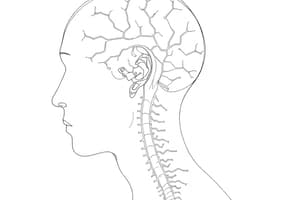Podcast
Questions and Answers
What is a primary function of the pyramidal tracts?
What is a primary function of the pyramidal tracts?
- Sensory perception from the body
- Regulation of skilled voluntary movements (correct)
- Involuntary control of body movements
- Coordination of reflex actions
What is the consequence of a lesion in the pyramidal tract?
What is the consequence of a lesion in the pyramidal tract?
- Loss of sensory function in the affected area
- Increased reflex activity in the affected muscles (correct)
- Reduced muscle tone in the affected body side
- Improved muscle coordination
Which of the following best describes the course of axons in the lateral corticospinal tract?
Which of the following best describes the course of axons in the lateral corticospinal tract?
- They decussate at the level of the medulla oblongata (correct)
- They terminate directly in the brain's cortex
- They ascend towards the brainstem
- They remain uncrossed throughout their path
What is the primary origin site of axons forming the corticobulbar tract?
What is the primary origin site of axons forming the corticobulbar tract?
Which aspect of bodily control is primarily managed by the anterior corticospinal tract?
Which aspect of bodily control is primarily managed by the anterior corticospinal tract?
How does the pyramidal system control body movements?
How does the pyramidal system control body movements?
Which area of the brain is primarily responsible for the origin of Betz cells involved in the pyramidal tract?
Which area of the brain is primarily responsible for the origin of Betz cells involved in the pyramidal tract?
The pyramidal tracts are named after which anatomical structure?
The pyramidal tracts are named after which anatomical structure?
What is the primary role of the lateral corticospinal tract in motor function?
What is the primary role of the lateral corticospinal tract in motor function?
What percentage of fibers decussate at the pyramidal decussation?
What percentage of fibers decussate at the pyramidal decussation?
Which of the following describes the course of the anterior corticospinal tract?
Which of the following describes the course of the anterior corticospinal tract?
What clinical implications arise from lesions in the upper motor neurons?
What clinical implications arise from lesions in the upper motor neurons?
In what part of the central nervous system do lower motor neurons supply muscles?
In what part of the central nervous system do lower motor neurons supply muscles?
What distinguishes the corticobulbar tract from the corticospinal tract?
What distinguishes the corticobulbar tract from the corticospinal tract?
Which area of the brain is primarily responsible for the origin of the corticospinal tract?
Which area of the brain is primarily responsible for the origin of the corticospinal tract?
What happens to the fibers within the lateral corticospinal tract after decussation?
What happens to the fibers within the lateral corticospinal tract after decussation?
What is the primary function of the corticobulbar tract?
What is the primary function of the corticobulbar tract?
Which cranial nerve nuclei are NOT bilaterally supplied by the corticobulbar tract?
Which cranial nerve nuclei are NOT bilaterally supplied by the corticobulbar tract?
What symptom is NOT typically associated with upper motor neuron syndrome?
What symptom is NOT typically associated with upper motor neuron syndrome?
How does a lesion in the pyramidal tract affect muscle tone?
How does a lesion in the pyramidal tract affect muscle tone?
Which of the following best describes an upper motor neuron lesion?
Which of the following best describes an upper motor neuron lesion?
Which of these options is a consequence of dysfunction in the corticobulbar tract?
Which of these options is a consequence of dysfunction in the corticobulbar tract?
What role does the pyramidal system play in motor control?
What role does the pyramidal system play in motor control?
Where does the lateral corticospinal tract decussate?
Where does the lateral corticospinal tract decussate?
Flashcards are hidden until you start studying
Study Notes
Pyramidal Tracts Overview
- Pyramidal tracts consist of upper motor neurons in the cerebral cortex involved in initiating and regulating voluntary movements.
- These tracts are named for their passage through the pyramids of the medulla oblongata.
- They originate mainly in the primary motor cortex (Betz cells, area 4) and premotor areas (area 6).
Corticospinal Tract Subdivisions
-
Lateral Corticospinal Tract:
- Contains fibers that decussate in the lower medulla (85-90%).
- Descends to terminate in the ventral horn of the spinal cord across all segmental levels.
- Supplies motor input to the body's musculature.
-
Anterior Corticospinal Tract:
- Remains ipsilateral before decussating.
- Primarily terminates in the ventral horn of cervical and upper thoracic spinal segments.
- Supplies musculature of the head and neck.
Corticobulbar Tract
- Comprises fibers that descend to the brainstem motor nuclei of cranial nerves.
- Controls muscles involved in facial expression, mastication, swallowing, and other functions.
- Supplies motor nuclei bilaterally except for the lower facial nucleus and hypoglossal nucleus, which receive input from the contralateral side.
Function of the Pyramidal System
- Transmits impulses responsible for skilled voluntary movements.
- Plays a critical role in higher motor functions, directing complex motor patterns.
Upper Motor Neuron Syndrome
- Lesions in the pyramidal tract commonly result in upper motor neuron syndrome due to its extensive pathway.
- Features include:
- Paralysis (absence of volitional movement)
- Increased muscle tone (spasticity)
- Exaggerated reflex responses
- Extensor plantar response in contralateral limbs
- Lesions classified as supranuclear, affecting pathways from upper motor neurons to lower motor neurons.
General Characteristics
- Pyramidal tracts can be categorized as descending tracts originating from the brain.
- Two main categories are distinguished: pyrimidal tracts and extrapyramidal tracts.
- The pathways are essential for motor activities, integrating voluntary control over body movements.
Studying That Suits You
Use AI to generate personalized quizzes and flashcards to suit your learning preferences.




